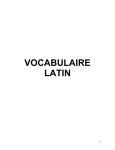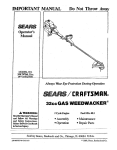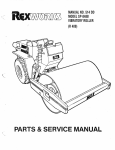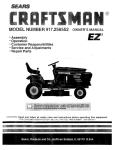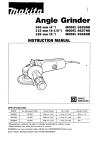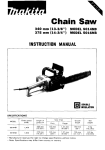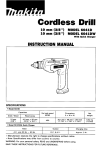Download Makita 5620DWB Instruction manual
Transcript
lped with Electric Brake IL5620DWA MODEL 5620DWB !h Capacity Battery Charger With High Capacity Battery Charger INSTRUCTION MANUAL SPE( Mo CATIONS 620D No load speed Cutting depth , 450 0-54" (0 - 2-1/8") (0- 1-1/2") 18 V I Cartridge 1833 18 V 0 - 3 8 mm 2,600 Overall length Net weight 3 6 4 mm 114-5/16") 3 . 4 kg ( 7 . 5 Ibsl Model DC1801 High capacity Battery charger Cartridge 1 8 2 2 loltage 'oltaae (RPMI 900 Input A.C. only 5 0 Hz - 60 Hz I Output D.C. 7 . 2 V - 18 V Charging time 1 1 Hr. Modal DC1801 High capacity Battery charger I I Inout A.C. only 50 Hz - 60 Hz I I OUtDUt D.C. 7 . 2 V - 18 V Man 4 Note WAR& turer reserves the right to change specifications without notice. ecifications may differ from country to country. For your personal safety, READ and UNDERSTAND before using. SAVE SE INSTRUCTIONS FOR FUTURE REFERENCE. 1 1 Charaina time 6 5 min. GENERAL SAFETY RULES (For All Battery Operated Tools) WARNING! Read and understand all instructions. Failure to follow all instructions listed below, may result in electric shock, fire and/or serious personal injury. SAVE THESE INSTRUCTIONS Work Area Keep your work area clean and well lit. Cluttered benches and dark areas invite .accidents. Do not operate power tools in explosive atmospheres, such as in the presence of flammable liquids, gases, or dust. Power tools create sparks which may ignite the dust or fumes. *Keep bystanders, children, and visitors away while operating a power tool. Distractions can cause you t o loose control. Electrical Safety A battery operated tool with integral batteries or a separate battery pack must be recharged only with the specified charger for the battery. A charger that may be suitable for one type of battery may create a risk of fire when used with another battery. U s e battery operated tool only with specifically designated battery pack. Use of any other batteries may create a risk of fire. Personal Safety Stay alert, watch what you are doing, and use common sense when operating a power tool. Do not use tool while tired or under the influence of drugs, alcohol, or medication. A moment of inattention while operating power tools may result in serious personal injury. Dress properly. Do not wear loose clothing or jewelry. Contain long hair. Keep your hair, clothing, and gloves away from moving parts. Loose clothes, jewelry, or long hair can be caught in moving parts. Avoid accidental starting. Be sure switch is in the locked or off position before inserting battery pack. Carrying tools with your finger on the switch or inserting the battery pack into a tool with the switch on invites accidents. Remove adjusting keys or switches before turning the tool on. A wrench or a key that is left attached to a rotating part of the tool may result in personal injury. Do not overreach. Keep proper footing and balance at all times. Proper footing and balance enable better control of the tool in unexpected situations. Use safety equipment. Always wear eye protection. Dust mask, non-skid safety shoes, hard hat, or hearing protection must be used for appropriate conditions. 2 I tform. Holding the work by hand or against your body is unstable and t o loss of control. use tool if switch does not turn it on or off. A tool that cannot be ed with the switch is dangerous and must be repaired. c h preventive safety measures reduce the risk of starting the tool tery pack is not in use, keep it away from other metal objects like: s, coins, keys, nails, screws, or other small metal objects that can Pa mc to: re. Keep cutting tools sharp and clean. Properly maintained M; to< with sharp cutting edge are less likely t o bind and are easier t o control. *Ch k for misalignment or binding of moving parts, breakage of parts, and any condition that may affect the tool’s operation. If damaged, have the tool ott sei *Us nly accessories that are recommended by the manufacturer for your !TIC Accessories that may be suitable for one tool may create a risk of injury used on another tool. wt . Sen Tot ervice must be performed only by qualified repair personnel. Service or ma ltenance performed by unqualified personnel may result in a risk of injury. o w t n servicing a tool, use only identical replacement parts. Follow instructions in I e Maintenance section of this manual. Use of unauthorized parts or failuie to lllow Maintenance Instructions may create a risk of shock or injury. 3 1 Specific Safety Rules 1. DANGER! Keep hands away from cutting area and blade. Keep your second hand on auxiliary handle, or motor housing. If both hands are holding the saw, they cannot be cut by the blade. Keep your body positioned t o either side of the saw blade, but not in line with the saw blade. KICKBACK could cause the saw t o jump backwards. (See "Causes and Operator Prevention of Kickback") Do not reach underneath the work while blade is rotating. The guard can not protect you from the blade below the work. Don't attempt t o remove cut material when blade is moving. CAUTION: Blades coast after turn off. 2. Check lower guard for proper closing before each use. Do not operate saw -. if lower guard does not move freely and close instantly. Never clamp or tie the lower guard into the open position. If saw is accidentally dropped, lower guard may be bent. Raise the lower guard with the Retracting Handle and make sure it moves freely and does not touch the blade or any other part, in all ang!es and depths of cut. 3.Check the operation and condition of the lower guard spring. If the guard and the spring are not operating properly, they must be serviced before use. Lower guard may operate sluggishly due t o damaged parts gummy deposits, or a buildup of debris. 4. Lower guard should be retracted manually only for special cuts such as "Pocket Cuts" and "Compound Cuts." Raise lower guard by Retracting Handle. As soon as blade enters the material, lower guard must be released. f o r all other sawing, the lower guard should operate automatically. 5. Always observe that the lower guard is covering the blade before placing saw down o n bench or floor. A n unprotected, coasting blade will cause the saw t o walk backwards, cutting whatever is in its path. Be aware of the time it takes for the blade t o stop after switch is released. 6.NEVER hold piece being cut in your hands or across your leg. It is important t o support the work properly to minimize body exposure, blade binding, or loss of control. 7. Hold tool by insulated gripping surfaces when performing an operation where the cutting tool may contact hidden wiring or its o w n cord. Contact with a "live" wire will also make exposed metal parts of the tool "live" and shock the operator. 8. When ripping always use a rip fence or straight edge guide. This improves the accuracy of cut and reduces the chance for blade binding. 9. Always use blades with correct size and shape (diamond vs. round) arbor holes. Blades that do not match the mounting hardware of the saw will run eccentrically, causing loss of control. IO. Never use damaged or incorrect blade washers or bolts. The blade washers and bolt were specially designed for your saw, for optimum performance and safety or operation. 4 I 11 iauses and Operator Prevention of Kickback: rickback is a sudden reaction to a pinched, bound or misaligned saw blade, ausing an uncontrolled saw to lift up and out of the workpiece toward the Iperator. Vhen the blade is pinched or bound tightly by the kerf closing down, the blade tails and the motor reaction drives the unit rapidly back toward the operator. f the blade becomes twisted or misaligned in the cut, the teeth at the back tdge of the blade can dig into the top surface of the wood causing the blade D climb out of the kerf and jump back toward operator. rickback is the result of tool misuse and/or incorrect operating procedures Y conditions and can be avoided by taking proper precautions as given below. naintain a firm grip with both hands o n the saw and position your body and r m t o allow you t o resist KICKBACK forces. KICKBACK forces can be ontrolled by the operator, if proper precautions are taken. Vhen blade is binding, or when interrupting a cut for any reason, release he trigger and hold the saw motionless in the material until the blade comes D a complete stop. Never attempt t o remove the saw from the work or pull he saw backward while the blade is in motion or KICKBACK may occur. ivestigate and take corrective actions to eliminate the cause of blade binding. Vhen restarting a saw in the workpiece, center the saw blade in th& kerf nd check that saw teeth are not engaged into the material. If saw blade ; binding, it may walk up or KICKBACK from the workpiece as the saw is ?started. ;upport large panels t o minimize the risk of blade pinching and KICKBACK. arge panels tend t o sag under their own weight. Supports must be placed nder the panel on both sides, near the line of cut and near the edge of the anel as shown in Fig. 1. o minimize the risk of blade pinching and kickback. When cutting operation ?quires the resting of the saw on the work piece, the saw shall be rested n the larger portion and the smaller piece cut off. --I To avoid kickback do support board or oanel near the cut. 1 I Fig. 1 I 1 Don't support board or panel away from the cut. Fig. 2 5 :. Do not use dull or damaged blade. Unsharpened or improperly set blades produce narrow kerf causing excessive friction, blade binding and KICKBACK. Blade depth and bevel adjusting locking levers must be tight and secure before making cut. If blade adjustment shifts while cutting, it may cause binding and KICKBACK. Use extra caution when making a "Pocket Cut" into existing walls or other blind areas. The protruding blade may cut objects that can cause KICKBACK. NEVER place your hand or fingers behind the saw. If kickback occurs, the saw could easily jump backwards over your hand, possibly causing severe injury. I Fie.3 12. Adjustments. Before cutting be sure depth and bevel adjustments are tight. 13. Avoid Cutting Nails. Inspect for and remove all nails from lumber before Eutting. 14. When operating the saw, keep the cord away from the cutting area and position it so that it will not be caught on the workpiece during the cutting operation. Operate with proper hand support, proper workpiece support, and supply cord routing away from the work area. A typical illustration of proper hand support, workpiece support, and SUDD~Vcord routinp. WARNING: Fig. 4 It is important t o support the workpiece properly and t o hold the saw firmly t o prevent loss of control which could cause personal injury. Fig. 4 illustrates typical hand support of the saw. 6 I 15 ace the wider portion of the saw base on that part of the workpiece which solidly supported, not on the section that will fall off when the cut is made. E examples, Fig. 5 illustrates the RIGHT way t o cut off the end of a board, id Fig. 6 the WRONG way. If the workpiece is short or small, clamp it down. 3N'T TRY TO HOLD SHORT PLACES BY HAND! Fig. 5 16 wer attempt t o saw with the -cular saw held upside down in a ;e. This is extremely dangerous and n lead t o serious accidents. Fig. f Fig: 17 !fore setting the tool down after completing a cut, be sure that the lower rlescoping) guard has closed and the blade has come t o a complete stop. 7 SYMBOLS The followings show the symbols used for tool. S ................................. ................................. ................................. ................................. ................................. ................................. ................................. 'L ................................. alternating current ---- ................................. direct current n, ................................. no load speed 'L ................................. alternating or direct current V A Hz kg h min volts amperes herts kilograms hours minutes seconds 1_1 *IuI .................................. Class II Construction I 8 A ................................. splash-proof construction bb ................................. watertight construction ..bin ................................ revolutions or reciprocation per minute @ ................................. number of blow I IPORTANT SAFETY INSTRUCTION’S FOR CHARGER & BATTERY CARTRIDGE @ 1 2 3 4 5 6 7 8 * Length of Cord (Feet) 25 50 100 150 AWG Size of Cord 18 18 18 16 9 10 11 12. 9 ADDITIONAL SAFETY RULES FOR CHARGER & BATTERY CARTRIDGE 1. Do not charge Battery Cartridge when temperature is BELOW 10°C (5OOF) or ABOVE 4OoC (104OF). 2. Do not attempt t o use a step-up transformer, an engine generator or DC power receptacle. 3.Do not allow anything to cover or clog the charger vents. 4. Always cover the battery terminals with the battery cover when the battery cartridge is not used. 5. A battery short can cause a large current flow, overheating, possible burns and even a breakdown. '(1 ) Do not touch the terminals with any conductive material. (2)Avoid storing battery cartridge in a container with other metal objects such as nails, coins, etc. (3)Do not expose battery cartridge t o water or rain. 6. Do not store the tool and Battery Cartridge in locations where the temperature may reach or exceed 5OoC (122OF). 7. Do not incinerate the Battery Cartridge even if it is severely damaged or is completely worn out. The battery cartridge can explode in a fire. SAVE THESE INSTRUCTIONS. c 10 Ins illing or removing battery cartridge *A lays switch off the tool before insertion 01 emoval of the battery cartridge. *TI 'emove the battery cartridge, withdraw it om the tool while pressing the buttons 01 30th sides of the cartridge. *TI insert the battery cartridge, align the t C 3ue on the battery cartridge with the 91 ive in the housing and slip it into place. A fays insert it all the way until it locks in PI :e with a little click. If not, it may accidi #tallyfall out of the tool, causing injury tc ou or someone around you. Fig. 8 .D not use force when inserting the battery cartridge. If the cartridge does not slide in ei ily, it is not being inserted correctly. Ch 'ging .YI ir new battery cartridge is not charged. Y( I will need to charge it before use. Use tt high capacity battery charger Model D 1801 to charge the battery cartridge. *PI 1 the high capacity battery charger into tt proper A.C. voltage source. The chargin light will flash in green color. *In ai tr rc bi in ?rtthe battery cartridge so that the plus minus terminals on the battery carge are on the same sides as their iective markings on the high capacity :ery charger. Insert the cartridge fully I the port so that it rests on the charger port floor. Fig. 9 en the battery cartridge is inserted, the charging light color will change from green to rE and charging will begin. The charging light will remain lit steadily during charging. .V\ *V\ en the charging light color changes from red to green, the charging cycle is complete ai the charger will switch into its "trickle charge (maintenance charge)" mode. The cl rging time is approximately one hour. ?rcharging, unplug the charger from the power source. CP TION: *TI high capacity battery charger Model DC1801 is for charging Makita battery cartridge. N fer use it for other purposes or for other manufacturer's batteries. en you charge a new battery cartridge or a battery cartridge which has not been used a long period of time, it may not accept a full charge. This is a normal condition and s not indicate a problem. You can recharge the battery cartridge fully after discharging Impletely and recharging a couple of times. *LA fc dc it 11 , , *If you charge a battery cartridge from a just-operated tool or a battery cartridge which has been left in a location exposed to direct sunlight or heat for a long time, the charging light may flash in red color. If this occurs, wait for a while. Charging will begin after the battery cartridge cools. The battery cartridge will cool faster if you remove the battery cartridge from the high capacity battery charger. *If the charging light flashes alternately in green and red color, a problem exists and charg ing is not possible. The terminals on the charger or battery cartridge are clogged with dust or the battery cartridge is worn out or damaged. Removing or installing the saw blade CAUTION: Always be sure that the tool is switched off and the battery cartridge is removed before installing or removing the blade. To remove the blade, press the shaft lock so that the blade cannot revolve and use the hex wrench to loosen the bolt clockwise. Then remove the bolt, outer flange and blade. Fig. 10 To install the blade, follow the removal procedure in reverse. BE SURE TO TIGHTEN THE BOLT SECURELY. Fig. 11 CAUTION: *Be sure the blade is installed with teeth pointing up at the front of the tool. *Use only the Makita hex wrench to install or remove the blade. 12 % He wrench storage W co n not in use, the hex wrench can be eniently stored. CI TION: AI ar iys be sure that the tool is switched off and the battery cartridge is removed before adjustment is attempted. AI isting depth of cut LC ;en the lever on the depth guide and m e the base up or down. Ai le desired depth of cut, secure the base bi ghtening the lever. C JTION: I Fig. 13 e a shallow depth of cut when cutting thin workpiece for cleaner, safer cuts. ., er adjusting the depth of cut, always tighten the lever securely. I. B el cutting L 0 a ti sen the screw on the bevel scale plate the front of the base. Set for desired le (0"- 50") by tilting accordingly, then ten the clamp screw securely. Bevel scale plate Screw Adjusting for accuracy of 90" cut (vertical cut) This adjustment has been made at the factory. But if it is off, adust the adjusting screw with a screwdriver while squaring the blade with the base using a triangular rule, trysquare, etc. Base \T Triangular rule I Fig. 15 CAUTION: After adjusting the depth of cut and bevel cutting angle, be sure to tighten the screw. Sighting The front of the base is notched to provide two guide edges. For straight cuts, align the edge with 0" engraved on it with your cutting line on the workpiece. For 45" bevel cuts, align the edge with 45" engraved on it with your cutting line. I For stright cuts For 45' bevel cuts Culting line Fig. 17 Switch action CAUTION: Before inserting the battery cartridge into the tool, always check to see that the switch trigger actuates properly and returns to the "OFF" position when released. To prevent the switch trigger from being accidentally pulled, a lock-off button is provided. To start the tool, depress the lock-off button and pull the switch trigger. Release the switch trigger to stop. Fig. 18 14 01 pation Hc the tool firmly. Set the base plate on thi vorkpiece to be cut without the blade . mi an ng any contact. Then turn the tool on Nc thi ad co sa ad simply move the tool forward over Norkpiece surface, keeping it flat and ncing smoothly until the sawing is Aeted. To get clean cuts, keep your ng line straight and your speed of nce uniform. wait until the blade attains full speed. I Base \ 1 Fig. l! CL TION: @P lays gently keep the tool moving straight ahead when cutting. Forcing or twisting the will result in overheating of the motor and dangerous kickback, possibly causing ct S ere injury. @Iire tool is operated continuously until the battery cartridge has discharged, allow the ti to rest for 15 minutes before proceeding with a fresh battery. GI Th ex thi thc thi al: PO le rule handy guide rule allows you to do ,-accurate straight cuts. Simply slide luide rule up snugly against the side of vorkpiece and secure it in position with lamp screw on the front of the base. It makes repeated cuts of uniform width ible. I I. Fig. 2 15 1 MAINTENANCE CAUTION: Always be sure that the tool is switched off and the battery cartridge is removed before attempting to perform inspection or maintenance. Replacing carbon brushes Remove and check the carbon brushes regularly. Replace when they wear down to the limit mark. Keep the carbon brushes clean and free to slip in the holders. Both carbon brushes should be replaced at the same time. Use only identical carbon brushes. Fig. 21 Use a screwdriver to remove the brush holder caps. Take out the worn carbon brushes, insert the new ones and secure the brush holder caps. Fig. 22 To maintain product SAFETY and RELIABILITY, repairs, maintenance or adjustment should be performed by Makita Authorized or Factory Service Centers, always using Makita replacement parts. Trickle charge (Maintenance charge) If you leave the battery cartridge in the charger to prevent spontaneous discharging after full charge, the charger will switch into its "trickle charge (maintenance charge)" mode and keep the battery cartridge fresh and fully charged. Tips for maintainingmaximum battery life 1. Charge the battery cartridge before completely discharged. Always stop tool operation and charge the battery cartridge when you notice less tool power. 2. Never recharge a fully charged battery cartridge. Overcharging shortens the battery service life. 3. Charge the battery cartridge with room temperature at 10°C Let a hot battery cartridge cool down before charging it. 16 - 40°C (50°F - 104°F). R cycling the Battery The only way to dispose of a Makita battery is to recycle it. The law prohibits any other method of disposal. I To cycle the battery: 1. 2. ?move the battery from the tool. . Take the battery to your nearest Makita Factory Service Center I Ni-Cd . Take the battery to your nearest Makita Authorized Service Center or Distributor that has been designated as a Makita battery recycling location. Call your nearest Makita Service Center or Distributor to determine the location that provides Makita battery recycling. See your local Yellow Pages under ”Tools-Electric’: A CESSORIES 0 TION: Tt m Tt e accessories or attachments are recommended for use with your Makita tool specified in this ial. The use of any other accessories or attachments might present a risk of injury to persons. iccessories or attachments should be used only in the proper and intended manner. .I h capacity battery charger DC1801 N0.192817-6 High capacity battery 182211833 tery cover No.414938-7 Hex wrench Part No. 783203-8 f .I f 01 F igsten carbide tipped saw blade Part No. wood I 726008-3 Diameter (mm) I 165 (6-1/2”) I Hole diameter (mm) 15.88 (51s”) No,teeth I 24 I 17 Juns-10-'98 US 165 mm (6-1/2") CORDLESS CIRCULAR SAW Model 5620D Note: The switch and other part configurations may differ from country to country. 1s MAKVA LIMrlED ONE YEAR WARRANTY Warranty Policy Every Makita tool is thorou ly inspected and tested before leaving the factory. It is warranted to be free of defects from worfknshrp and materials for period of ONE YEAR from the date of original purchase. Should any trouble develop during this oneyear period, return the COMPLETE tool, freight prepaid, to one of Makita's Factory or Authorized Service Centers. If inspection shows the trouble is caused by defective workmanship or material. Makita will repair (or at our option, replace) without charge. This Warranty does not apply where: repairs have been made or attempted by others: repain are required because ofnormal w e u and tear: The tool has been abused, misused or improperly maintained; alterations have been made to the tool. IN NO EVENT SHALL MAKITA BE LIABLE FOR ANY INDIRECT, INCIDENTAL OR CONSEQUENTIAL DAMAGES FROM THE SALE OR USE OF THE PRODUCT. THIS DISCLAIMER APPLIES BOTH DURING AND AFTER THE TERM OF THIS WARRANTY. MAKITA DISCLAIMS LIABILITY FOR ANY IMPLIED WARRANTIES, INCLUDING IMPLIED WARRANTIES OF "MERCHANTABILITY" AND "FITNESS FOR A SPECIFIC PURPOSE." AFTER THE ONE-YEAR TERM O F THIS WARRANTY. This Warranty gives you specific l e p l rights. and you may also have other rights which vary from state to state. Some states do not allow the exclusion or limitation of incidental or consequential damages. so the above limitation or exclusion may not apply to you. Some states do not allow limitation on how long an implied warranty lasts. so the above limitation may not apply to you. Makita Corporation of America 2650 Buford Hwy., Buford, GA 30518 884192-063 PRINTED IN U S A . MCI 38 1998-7-GS Juna-lO-'SB MODEL 5 6 2 0 0 ,!& M ", MACHINE 1 2 3 4 5 6 7 8 9 10 11 12 13 14 15 16 17 10 10 20 21 22 23 24 25 26 27 26 1 1 1 1 1 1 1 1 1 1 1 1 1 1 1 1 I 1 2 1 1 3 29 6 1 2 1 1 1 1 30 31 1 1 $fD DESCRIPTION US DESCRIPTION MACHlNE Hex Socket Head &If M6x2O Outer FIangs 40 Inner Flange 40 Spmdle Basring Relamer 10-33 Ball Baarmg 62010DW R a t a n m i Ring 5-38 Salsly CO"., Ring 12 Tensron Spring 3 Countersunk Screw M6 Rubber Ring 6 Msksa Lab1 Compression Spnng 5 Blade Cane Complete Ball b a r m e 606 Spur Gear 53 Bo" BOX Countersunk Hoed S E ~ W M5x16 SWilCh h i i o n Comprarrlon sprmg 4 Pan Head Screw M5840 Tapping Screw 4x10 HandlsCovar Tappmg Screw 4x10 Rear Cover NamePlata Motor Housmg Yoke Unll &11le male Ball Benrmg 627LLB 32 1 33 34 35 I 36 37 38 30 4 0 41 42 43 44 45 46 47 40 49 60 51 52 53 64 55 58 67 56 59 60 81 1 1 1 1 1 2 1 2 2 1 1 1 1 1 1 1 1 1 1 2 1 3 1 1 1 1 1 1 , ARMATURE ASSEMBLY IWlIh Item 31. 33 & 351 Fan 55 Shall Lock 81 .1 0" 6000LLB Cmpre..lon sprvlp 7 Screw M e l t 4 H a l L w k Nut M5-0 Tappmp Screw MT 4x60 Brush Hddw Carbon 0ru.h Holder Cap stop Rl"0 E-8 Hex Nut M6 Lever 4 0 FI.1 Washer 6 Switch Switch Lever @atloryHolder Depth Complete FIaI Head Screw M6r9O b.0 Countersunk H o d S o s w M4x0 Screw M5r12 Counlerwnk Head Suew MSx0 Pam tiead Screw M5 Flat Washer 6 Spnng Washer 6 Sctmw M 6 x l 4 AnpYI.i Complete Brush Holder 19




















